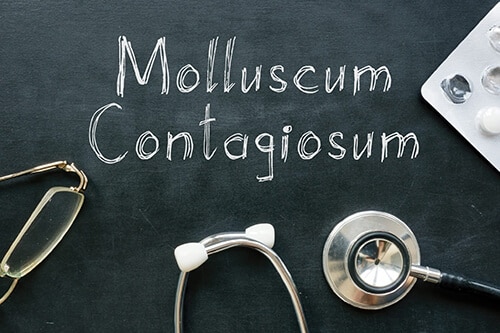Molluscum Contagiosum Caused by a Viral Infection

Molluscum contagiosum is an infection caused by a virus that results in benign lesions all over the body. The lesions are commonly referred to as mollusca.
Mollusca may occur anywhere on the body, alone or in groups. The lesions are rarely found on the palms of the hands or the soles of the feet. Molluscum contagiousum most frequently appears on the following areas:
Molluscum contagiosum is a highly contagious virus, spread by human contact as well as object to person contact. Everyday objects such as furniture, linens, clothing, towels, bathing sponges, pool equipment, and toys are common contact sources. It’s common for children to contract the virus in school. In adults, molluscum contagiosum is frequently acquired at the gym or through sexual contact.
Never scratch your rash, no matter how itchy it becomes. If you break open the lesions by scratching, you run the risk of contracting a painful bacterial infection within your rash. It’s especially important not to scratch your mollusca, because you may release fluid and unintentionally spread the virus to other parts of your body. It’s also important to remember that when you scratch, you are likely to shed tiny flakes of skin onto surrounding objects, making it more likely that you will spread molluscum contagiosum to others.
Your doctor may recommend freezing the lesions with liquid nitrogen or removing them with a curette. Laser therapy may also be recommended in more severe cases. These treatment methods are the fastest and most effective way to eliminate mollusca, though the process can be slightly painful. Local anesthesia is often used, and your doctor may recommend a mild pain medication while you are healing.
Gradual elimination of molluscum contagiosum may be achieved through oral medication, such as cimetidine. This treatment is effective, but it takes longer to see results. While oral medication is safe, painless, and well tolerated, it is not as effective on facial mollusca. Oral medication is most commonly recommended for children, because it is an easier treatment method compared to physical lesion removal.
A variety of prescription topical creams and ointments are available for the treatment of molluscum contagiosum. Topical treatments effectively reduce the symptoms of molluscum contagiosum, but they are not fully effectively at killing the virus that causes molluscum contagiosum.
Molluscum contagiosum typically resolves without scarring on its own anywhere from six months to a year. In severe instances, it can take years to disappear.